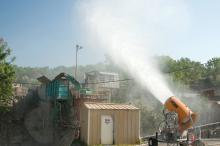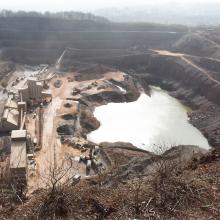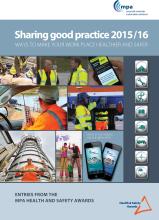
Legislative and social pressure is increasing the demand for quantified monitoring of dust and respirable particulates as ABE discovered
Local and environmental authorities and health at work bodies are paying ever more attention to dust issues, both in terms of potential nuisance and because of any possible health implications.
“I’ve observed two phases. Initially, authorities were primarily interested in ensuring simply that something was being done about dust suppression. “But now more and more they are asking for some numbers,” says Francesco Fritz, sales director at
There are two distinct issues: dust that causes nuisance and respirable particulates (the invisible pollutants that have potential health impacts if they get into the lungs).
Nuisance dust is easy to describe but hard to define. “There aren’t any set standards for nuisance dust,” says Dr Hugh Datson, senior environmental scientist at
Dust problems near a minerals site are generally regarded as relating to nuisance issues rather than respirable particulates. But even with low levels of deposited dust, there is no absolute guarantee that there is not an issue with respirable dust as well, says
Quarries tend to be identified as the obvious source. “But sometimes the finger is pointed incorrectly,” says Holford. “Rather than just a number, you need to know where it is all coming from as well.”
Local authorities have a statutory duty to establish if there are any breaches of European limit values for PM10 (the respirable particles measuring less than 10 microns). An air quality management (AQM) area has to be declared if limits are exceeded at relevant receptor locations. “That is a driver for a lot of monitoring,” says Holford.
The regime began about ten years ago but the focus has increased. It is still unusual for an AQM to be declared for a minerals site, though some do exist.
“There have been some improvements in terms of monitoring over the last few years but the fundamentals remain the same,” says Holford. Looking into respirable particulates involves the higher end of the equipment range. But for non-respirable dust, traditional methods such as sticky pads are still absolutely fine. “The bottom line is that you are trying to monitor subjective reactions to deposited dust,” he says.
There are of course ways of measuring dust in real time but they are expensive, says Datson. “Expecting the minerals industry to rely too much on technology would be unreasonable and prohibitive.” By and large, nuisance dust involves perception rather than a health risk. “Therefore it is legitimate to balance the cost and use a relatively inexpensive way of keeping an eye on things,” he says.
The Mineral Industry Research Organisation published a 50-page good practice guide in February. It was prepared by
The site operator and the regulator should agree on the methods and thresholds and these should be proportional to the perceived risk, it recommends.
The most comprehensive dust monitoring will be a mix of continuous and intermittent sampling to establish long-term trends and capture transient events, says the guide. Techniques can be classified as passive (not requiring a power source) and active.
Visual monitoring is one of the principle approaches while another is dust deposition. This can be done either through monitoring surface soiling or by measuring the dust mass. Another approach is dust flux - the measurement of the horizontal transport of dust. It can be measured as mass using a BS 1747: Part 5 collector or with cylindrical adhesive samples.
DustScan, which was started at the University of Leeds in England, was set up with the aim of providing a better method for dust flux sampling than the existing British Standard monitoring approach.
“Ours was devised to be more sensitive because a cylinder is far more aerodynamically clean than four tubes with holes,” says Datson.
The DustScan method is a passive sampling system, based on a vertical cylinder fitted with a transparent adhesive film that captures dust entrained in the air. “We take the sample on the sticky surface, encapsulate it and it is then imaged on a flatbed scanner and run through the software to quantify the results,” says Datson. The reports in 15° arc segments can be used to indicate patterns of propagation.
DustScan currently carries out the scanning and analysis itself but is redeveloping the software with the aim of releasing it for other consultants to carry this out as well.
As an alternative to the standard method,
Datson’s research at Leeds University will soon be published and he hopes this will lay to bed some of the issues. Tied in with monitoring is the prospect of integration into water mist dust suppression units to provide real-time control.
“I think that in the next several years you will see a lot more people wanting to connect dust monitoring equipment to their dust control equipment,” says Edwin Peterson, president of
Such systems also lend themselves to web-based applications. “If one of our clients wants to do that, we have the inputs available but right now they tend to rely on a visual reminder that it’s dusty and time to turn on the suppression system.”
Dust Control Technology launched a strategic collaboration last year with SMI Evaporative Solutions to apply computer-controlled automation for monitoring and managing dust suppression equipment. The resulting systems can be programmed to manage start/stop cycles based on dust monitor readings, motion sensors, weather input or operator remote control.
Traditional ways of monitoring dust cannot supply the data in real time and the information they produce is an average over the measurement period, says Fritz. Automated control of suppression equipment requires development that goes beyond this. EmiControls by TechnoAlpin was set up recently as a separate company to focus on this kind of topic. The new company has taken on the dust applications previously handled by TechnoAlpin pro air solutions. “By becoming independent, the goal is really to have a focus on the topic and develop our own identity for dust suppression and emission control,” says Fritz.
The company started research two years ago to develop a system to make the information available in real time. A factor that has to be taken into account is that the measurements are obtained in an environment that contains both dust and water mist: the mist mustn’t bias the results. “We found systems on the market making dust measurements in real time but they were too sensitive to the water,” he says.
EmiControls is developing its own system. “One application is to control the equipment,” says Fritz. “It could also be used by the customer to monitor dust on site.” Management at source using real-time data is eminently sensible as relatively cheap monitoring technology can be used to give an indication of emissions at any given time, says Holford.
But monitoring is only part of the story. “Good site management is absolutely essential,” says Datson.
A good practice guide available from: %$Linker:








